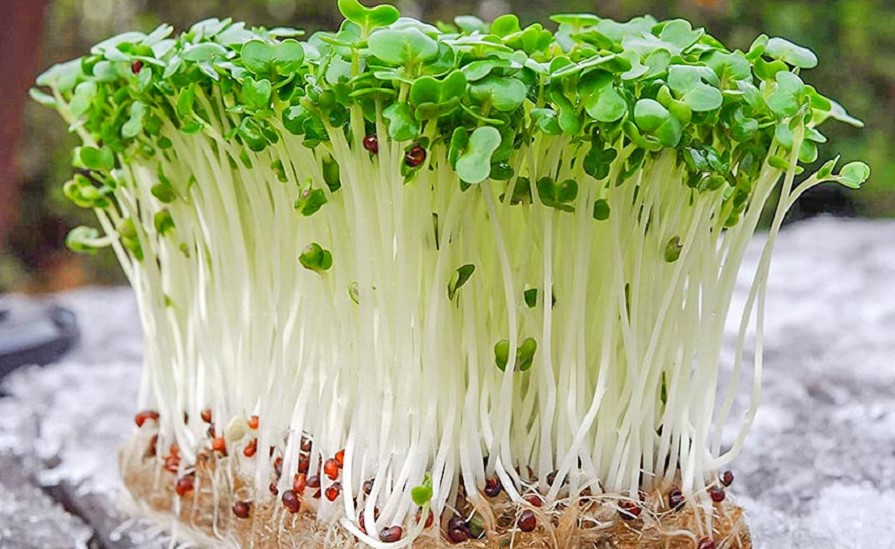Growing lettuce microgreens is an easy and rewarding way to add fresh, nutritious greens to your diet year-round.
Microgreens are young plants that are harvested just after the cotyledon leaves appear, and they pack a punch of flavor and nutrition in a small package.
This article will explore the benefits of growing microgreens, how to get started, and some tips for success.
Whether you have a small space or a green corner, you can easily grow lettuce microgreens in your own home.

Contents
- 1 What are lettuce microgreens?
- 2 Choosing the right lettuce varieties for microgreens
- 3 The growing process
- 4 Setting up your microgreen growing space
- 5 Planting lettuce microgreens
- 6 Caring for lettuce microgreens
- 7 Harvesting and storing lettuce microgreens
- 8 Tips for successfully growing lettuce microgreens indoors
- 9 FAQ
- 10 Conclusion
What are lettuce microgreens?
Lettuce microgreens are a type of young, edible plant that is grown from lettuce seeds.
They are typically harvested when the plants are just a few inches tall. And they are often used as a garnish or as a salad ingredient mixed with olive oil.
Lettuce microgreens have a mild, lettuce-like flavor and a tender, delicate texture.
They are rich in vitamins and are often considered a superfood due to their high levels of minerals and antioxidants.
It is easy to grow microgreens as they can be grown indoors or outdoors, in soil, or hydroponically.
You can grow lettuce microgreens in small containers, making them a convenient option for home gardeners or those with limited space.
Health benefits
Lettuce microgreens are a nutritious and flavorful addition to any diet.
Some of the potential health benefits of these greens include:
High in nutrients: They are rich in vitamins A, C, and K, as well as minerals such as calcium, potassium, and iron.
Boosts immunity: Lettuce greens are a good source of antioxidants, which may help to boost the immune system and protect against free radical damage.
Improves eye health: Lettuce microgreen contains lutein and zeaxanthin, two antioxidants that may help to protect the eyes from damage and improve vision.
Reduces the risk of chronic diseases: The vitamins may help to reduce the risk of chronic diseases such as cardiovascular disease, diabetes, and cancer.
Improves digestion: Lettuce microgreens contain fiber, which may help to improve digestion and prevent constipation.
Other purposes
Lettuce microgreen is a versatile ingredient that can be used in a variety of dishes, including salads, sandwiches, and wraps.
They are also popular choices for garnishing plates or adding a fresh, green touch to dishes.
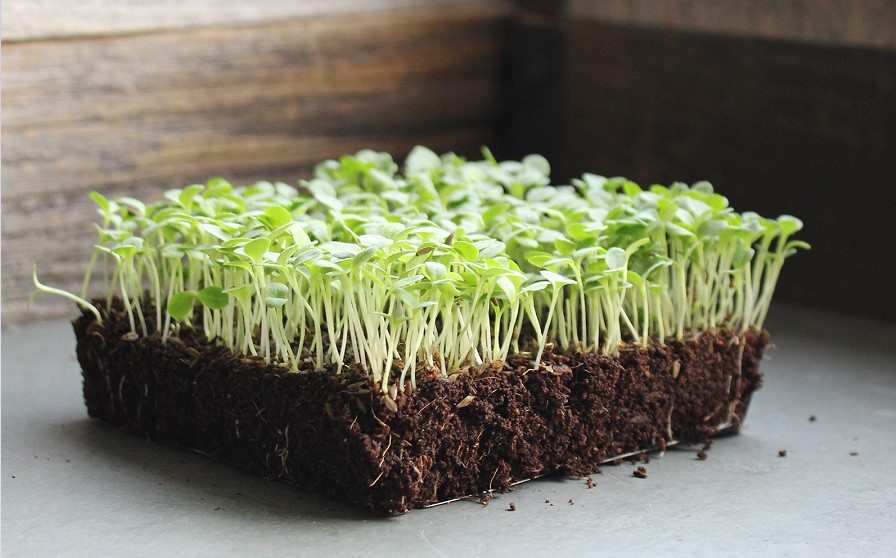
Choosing the right lettuce varieties for microgreens
When it comes to choosing the right lettuce varieties for microgreens, there are a few key factors to consider. Here are some tips for selecting the best lettuce varieties for microgreens.
Consider the flavor and texture
Different lettuce varieties have different flavors and textures, so it’s proper to choose a type that will complement the other ingredients in your dish. For example, if you want a crunchy texture, you might choose a variety like romaine.
If you prefer a softer texture, you might choose a variety like butterhead lettuce.
Think about the growing conditions
Some lettuce varieties are more tolerant of different conditions than others. For example, some types are more heat-tolerant, while others are more cold-tolerant.
Consider the conditions in your grow space and choose a variety that is well-suited to those conditions.
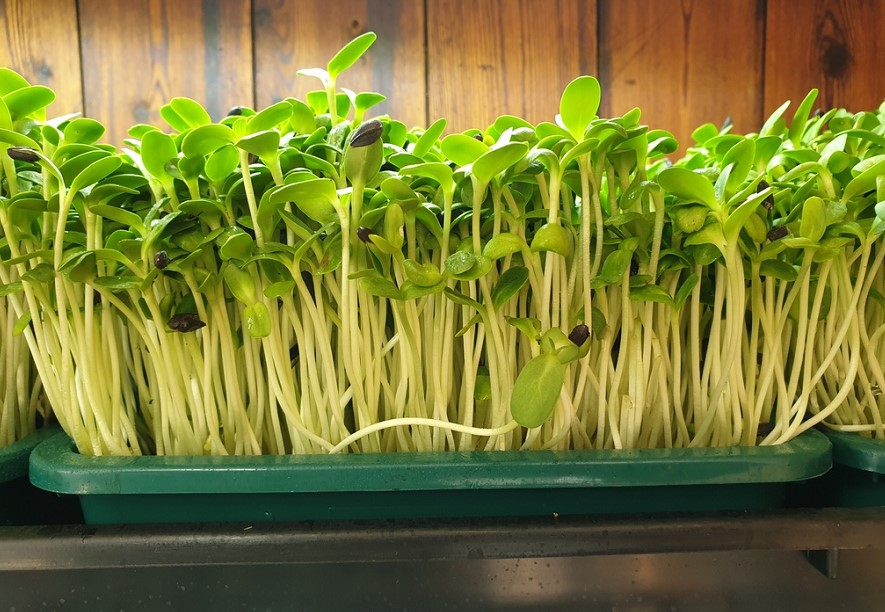
Consider the growing time
Different lettuce varieties have different growth times, so it’s reasonable to choose a sort that will mature within your desired timeframe.
If you want to harvest your microgreens quickly, you might choose a variety that has a shorter time.
Look for disease resistance
Lettuce can be prone to certain diseases, so it’s important to choose a variety that is resistant to common problems like downy mildew or lettuce mosaic virus.
Experiment
There are many different lettuce varieties available, so don’t be afraid to try a few different ones to see which ones you like best.
You might find that you prefer the flavor of one variety over another, or that certain varieties are easier to grow in your specific grow space.

The growing process
Lettuce microgreens are grown from lettuce seeds and harvested when they are just a few inches tall, typically 7-14 days after germination.
They are grown in shallow trays filled with soil and watered regularly to keep the soil moist.
Lettuce microgreen needs at least 6 hours of indirect light per day to grow properly.
The growing process is relatively simple and can be done at home with minimal equipment.
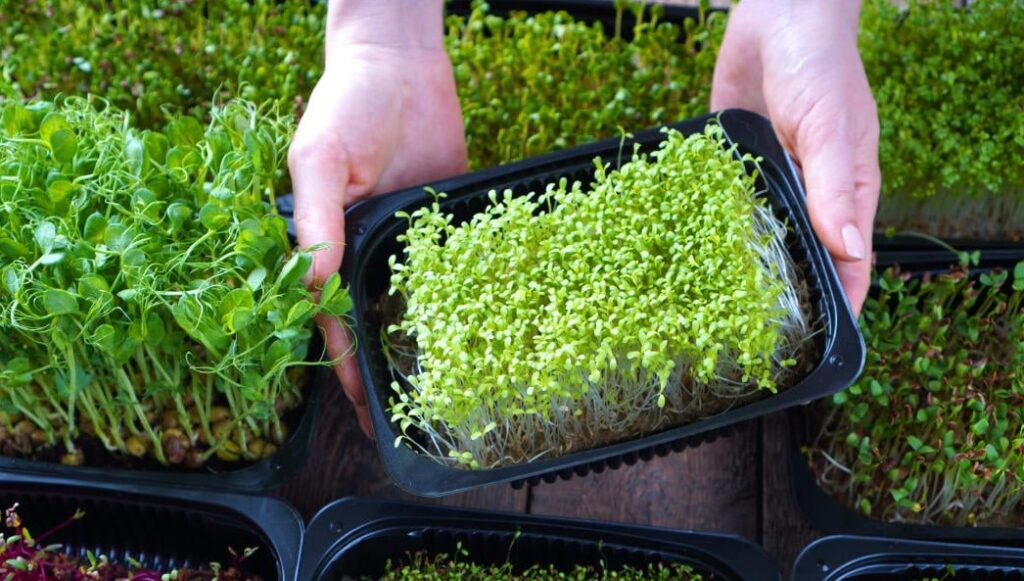
Setting up your microgreen growing space
To set up your microgreens growing space, you’ll need to consider several factors, including the size of your area, what you want to grow, and the equipment and materials you’ll need.
Here are some steps to follow when setting up your microgreen growing space:
Choose a suitable location
Microgreens can be grown indoors or outdoors, depending on your preferences. If you’re growing indoors, choose a location with plenty of indirect light, such as a windowsill or grow light setup.
Select your containers
Greens can be grown in various containers, including trays, pots, or recycled containers like yogurt cups or egg cartons.
Just make sure the tray has drainage holes to allow excess water to drain away.
Choose your growing medium
Microgreens can be grown in soil or hydroponically.
If you’re using soil, choose a high-quality, well-draining potting mix.
If you’re growing hydroponically, you’ll need a hydroponic growing system, such as a nutrient film technique (NFT) system or a deep water culture (DWC) system.

Set up the grow lights
You’ll need to provide your microgreens with artificial lighting if growing indoors.
Choose a grow light setup that provides the right intensity and spectrum of light for your specific microgreens.
Gather your seeds
Choose the seeds you want to grow, and make sure you have enough microgreen seeds for the size of your growing space.

Plant your seeds
Follow the specific planting instructions for your chosen seeds. Water the microgreen seeds gently and keep them watery until they germinate.
Following these steps will help you to set up a successful space to grow microgreens and enjoy fresh, nutrient-rich microgreens in no time.
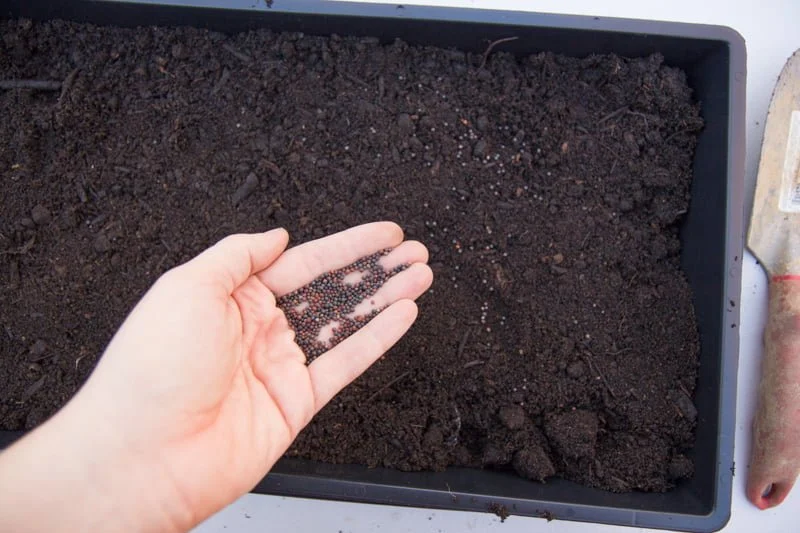
Planting lettuce microgreens
Lettuce microgreens are a fast-growing, nutritious, and flavorful addition to any meal. Here’s how to grow them at home.
To grow lettuce microgreens using seeds, follow these steps:
- Choose a tray with drainage holes, such as a seed tray or shallow container. Fill it with a sterile seed starting mix or potting soil.
- Take the lettuce mix seeds, and spread evenly them over the soil surface. Gently press them into the soil, but do not cover them.
- Water the lettuce seeds gently, using a watering can or spray bottle. Keep the soil wet but not waterlogged.
- Place the tray in a well-lit location, such as a sunny windowsill or under grow lights. Greens need at least 6 hours of indirect sunlight per day.
- After about 7-14 days, the micro lettuce will be ready to harvest. Cut with scissors just above the soil line.
- Once they have been gathered, you can plant a new batch by sowing more lettuce seeds in the same trays.

Baby leaf lettuce
To grow lettuce microgreens using lettuce plant or baby leaf lettuce, follow these steps:
- The tray should have drainage holes, for example, seed trays or shallow containers. Fill it with a sterile seed starting mix or potting soil.
- Cut the baby leaf lettuce into small pieces and place them evenly over the soil surface. They should be lightly covered in soil.
- Water the baby leaf lettuce gently using a watering can or spray bottle. Keep the soil moist but not soggy.
- Set the tray in a well-lit location, such as a sunny windowsill or under grow lights. Remember, at least 6 hours of indirect sun per day is needed for proper care.
- After about 7-14 days, the lettuce microgreen will be ready to harvest. Cut them with scissors just above the soil line.
- You can start a new batch by cutting more baby leaf lettuce and placing it in the same tray.
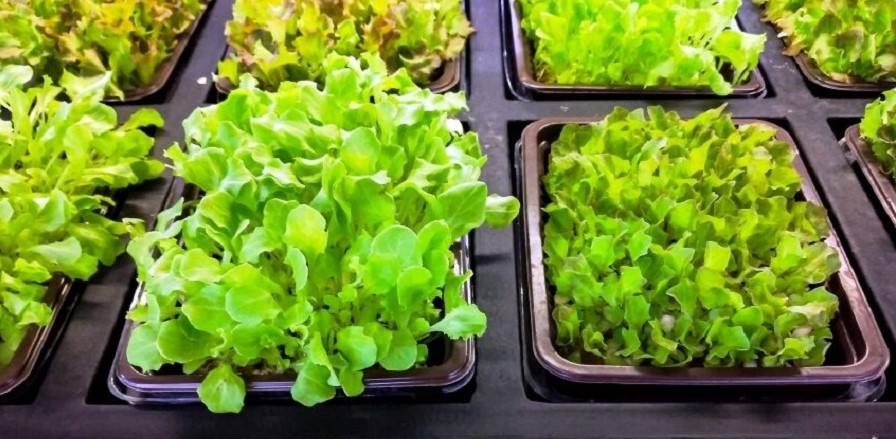
Caring for lettuce microgreens
To care for lettuce microgreens, follow these guidelines:
Don’t waterlog the soil. Water gently, using a watering can or spray bottle. Overwatering can lead to waterlogged soil, which can encourage the growth of fungi that cause damping off. By keeping the surface dry and well-ventilated, you can help prevent this disease and promote the healthy growth of the lettuce microgreens.
Place the tray in a well-lit location, such as a sunny windowsill or under grow lights. Lettuce microgreen needs at least 6 hours of indirect sunlight per day.
Protect from extreme temperatures, as lettuce is sensitive to cold and heat. Keep them away from drafts, and provide some shade during the hottest parts of the day.
You may fertilize it if needed. You can use a diluted liquid fertilizer or add a small amount of compost to the soil. However, be careful not to over-fertilize, as this can lead to poor growth and a bitter taste.
Check for pests and diseases regularly. To prevent damping off, keep the soil surface dry and well-ventilated, and avoid overwatering.

Harvesting and storing lettuce microgreens
Harvesting lettuce microgreens
Here are steps to properly harvest lettuce microgreens:
- When the microgreens are about 2-3 inches tall, or after about 7-14 days, they will be ready to harvest.
- Cut them with scissors just above the soil line.
- Rinse thoroughly and pat them dry before using them.
Note
When harvesting lettuce, it’s noteworthy to be careful not to remove the roots from the ground, as this can damage the plant and prevent it from growing properly.
Cut the leaves off at the base of the plant, leaving about 1/2 inch of the stem attached to the roots. This will help to prevent the unintentional gathering of trash or seed hulls that may be stuck to the stem.
Storing lettuce microgreen
To store lettuce microgreen, follow these steps:
- Place the microgreens in a damp paper towel or cloth, and wrap them in a plastic bag.
- Store in the refrigerator, in a location that is not too cold (such as the crisper drawer).
- For the best quality, Use the lettuce microgreens within a few days of harvesting.
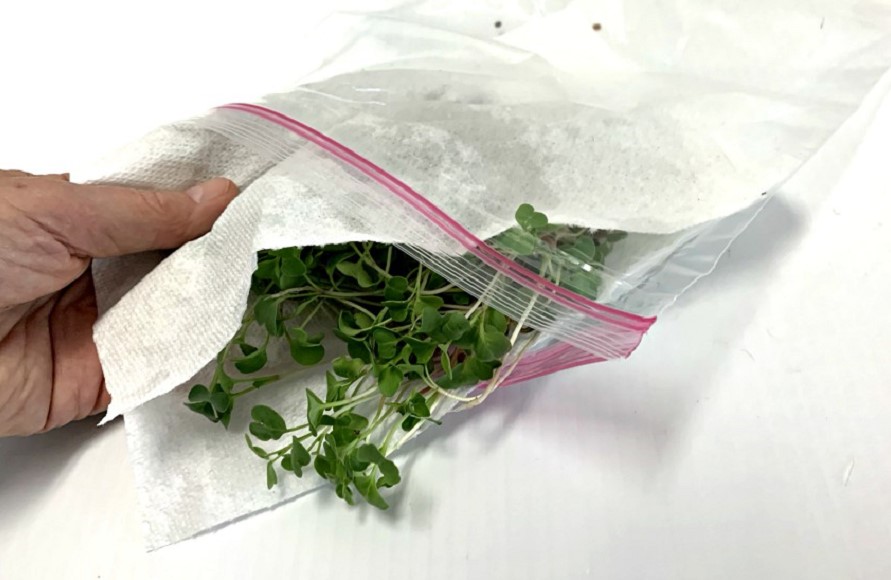
Tips for successfully growing lettuce microgreens indoors
Follow these additional tips to grow healthy microgreens indoors.
To grow lettuce microgreens successfully, it’s necessary to use a soil or seed starting mix free of weeds and diseases.
Lettuce microgreens need moisture to grow, but too much water can lead to waterlogged soil, which can cause the seeds to rot and die. To prevent damping off, it’s essential to keep the topsoil dry and well-ventilated. Water gently, using a watering can or spray bottle.
Avoid overcrowding the seeds, as this can lead to disease. Lettuce microgreens need space to grow and develop properly.
Uneven distribution may lead to competition for light, nutrients, and water, leading to poor harvesting and increased vulnerability to diseases.

FAQ
How long do lettuce microgreens take to grow?
Lettuce microgreens typically take 7-14 days to grow, depending on the variety and the cultivating conditions.
What is the healthiest microgreen?
It’s hard to determine which microgreen is the most nutritious since it offers various health benefits, and there is a nutritional difference between other microgreens.
Some baby greens known for their high nutrient content include kale, broccoli, and arugula.
They are packed with vitamins, minerals, and antioxidants. It is best to incorporate a variety of them into your diet.
Conclusion
Lettuce microgreens are a great way to add nutrition and flavor to your meals. They are easy to grow at home, requiring only a tray with soil, water, and light.
Just sow the seeds, keep the soil moist, and provide plenty of indirect light, and you can enjoy a continuous supply of fresh lettuce microgreen.
These microgreens can be used in different dishes, including salads, sandwiches, a garnish, or smoothies.
So why wait? Start growing lettuce microgreen today and enjoy the taste of fresh, homegrown goodness anytime you want!

